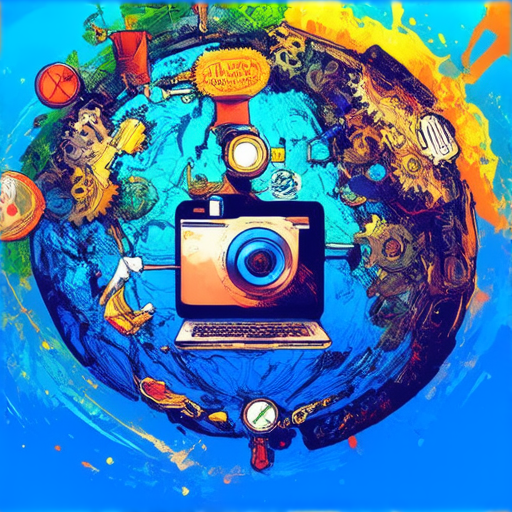As the world grapples with pressing social issues, activist media platforms have emerged as powerful tools for mobilizing public opinion and driving meaningful change. From social media giants like Twitter and Facebook to specialized platforms designed specifically for activism, these digital spaces offer a range of features and functionalities that enable activists to craft and disseminate their messages with greater ease and effectiveness. In this comprehensive guide, we’ll delve into the world of activist media platforms, exploring the most popular social media platforms used by activists, the key features of activist-friendly platforms, and the best practices for leveraging digital activism tools to maximize impact.
Whether you’re a seasoned activist or just starting out, understanding the ins and outs of activist media platforms is crucial for amplifying your message and achieving your goals. By examining the latest trends and innovations in digital activism, as well as the most effective strategies for using these platforms, you’ll be equipped with the knowledge and skills necessary to harness the power of activist media platforms and drive real change.

Popular Social Media Platforms Used by Activists
- Facebook: A widely-used platform for spreading awareness about social causes, organizing events, and mobilizing supporters.
- Instagram: Utilized for visually-driven campaigns, hashtags, and influencer partnerships to reach a broader audience.
- Twitter: Effective for real-time updates, live tweeting, and engaging with influencers and activists worldwide.
- TikTok: Leveraging its short-form video capabilities to create engaging, shareable content and raise awareness about social issues.
- Reddit: Participating in subreddits related to activism and social causes to connect with like-minded individuals and promote discussions.
- WhatsApp: A private messaging platform for coordinating efforts, sharing resources, and facilitating communication among activists.
Why These Platforms?
Activists often choose these platforms due to their large user bases, ease of use, and flexibility in terms of content creation and engagement.
Key Features for Activists
- Hashtag Campaigns: Utilize relevant hashtags to increase visibility and reach a wider audience.
- Influencer Partnerships: Collaborate with social media influencers to amplify messages and expand reach.
- Live Streaming: Leverage live streaming capabilities to broadcast events, rallies, and town halls, increasing engagement and participation.
- Private Messaging Groups: Use WhatsApp or similar platforms to coordinate efforts, share resources, and facilitate communication among activists.
Best Practices for Activists
- Be Authentic: Share genuine, heartfelt content that resonates with your target audience.
- Engage Consistently: Regularly post high-quality content to maintain audience interest and build momentum.
- Monitor and Adapt: Continuously track analytics, adjust strategies accordingly, and stay informed about platform changes and trends.
Examples of Media Activism
Media activism encompasses various forms of expression and engagement, utilizing diverse channels to raise awareness, promote social change, and mobilize public opinion. Some notable examples of media activism include:
- Documentary Films: Documentaries have become a powerful tool for media activism, shedding light on critical issues such as environmental degradation, human rights abuses, and social injustices.
- Podcasts: Podcasts offer a unique platform for media activists to share their stories, experiences, and perspectives, often sparking meaningful conversations and inspiring collective action.
- Social Media Campaigns: As mentioned earlier, social media campaigns can be an effective means of reaching a wide audience, mobilizing support, and driving policy changes.
- Television and Film Productions: Media activists can utilize television and film productions to amplify marginalized voices, challenge dominant narratives, and promote positive representation.
- Print Journalism: Investigative journalism has long been a cornerstone of media activism, exposing corruption, holding those in power accountable, and informing the public about pressing issues.
- Online Communities and Forums: Online communities and forums provide a space for media activists to connect, share resources, and collaborate on initiatives, fostering a sense of solidarity and collective purpose.
By leveraging these various channels, media activists can effectively amplify their message, build momentum, and drive lasting social change. Effective media activism requires a deep understanding of the issues, a commitment to social justice, and a willingness to take bold action – ultimately leading to a more informed, engaged, and empowered public.
Digital Activism Platforms
Digital activism has become a crucial aspect of modern social movements, allowing individuals to mobilize and raise awareness about various causes worldwide. Various platforms have emerged to facilitate this type of activism, enabling users to engage with others who share similar interests and goals.
- Online Petitions: Websites such as Change.org, iPetition.org, and Avaaz.org provide a platform for users to create and sign online petitions, which can help bring attention to a particular issue or cause.
- Social Media Campaigns: Social media platforms like Twitter, Facebook, Instagram, and YouTube offer a range of features that enable users to create and share content related to their cause, mobilizing support and raising awareness among their followers.
- Blogosphere and Online Communities: Blogs, forums, and online communities centered around specific topics or issues allow users to connect with others who share similar interests and passions, facilitating discussion and collaboration.
- Video Sharing Platforms: Sites like Vimeo, YouTube, and TikTok provide a space for users to create and share videos related to their cause, helping to amplify their message and reach a wider audience.
- Mobilization Tools: Apps like Change.org’s “Create a Petition” and SumOfUs’s “Take Action” enable users to easily create and distribute petitions, making it easier to mobilize support for a particular cause.
These platforms have revolutionized the way people engage in activism, offering a range of tools and resources that can help individuals and groups effectively mobilize and advocate for change. By leveraging these digital activism platforms, individuals can increase their impact, reach a wider audience, and contribute to meaningful social change.
The Most Influential Media Platform
Determining the most influential media platform can be subjective, as it depends on various factors such as audience demographics, engagement rates, and content types.
- Facebook: With over 2.7 billion monthly active users, Facebook remains one of the largest and most influential media platforms globally. Its vast user base spans across diverse age groups, geographical locations, and interests.
- YouTube: As the second-largest search engine in the world, YouTube boasts over 2 billion monthly active users. Its video-centric approach has made it an essential platform for entertainment, education, and advertising.
- Instagram: Owned by Meta Platforms, Inc., Instagram has become a significant influencer in the digital landscape. Its visually-driven interface and e-commerce features have attracted millions of users worldwide.
- TikTok: This short-form video-sharing app has gained immense popularity among younger generations. With its creative tools and algorithm-driven “For You” page, TikTok has become a go-to destination for entertainment and community-building.
- Twitter: As a real-time discussion platform, Twitter has established itself as a hub for news, politics, and celebrity interactions. Its character limit and hashtag system facilitate concise yet impactful communication.
While these platforms hold significant influence, it’s essential to consider niche audiences and specialized communities. For instance:
- Reddit**: A hub for discussions centered around specific topics, subreddits cater to diverse interests and provide valuable insights into particular subjects.
- Discord**: Primarily used for gaming communities, Discord offers advanced chat features and server management capabilities, making it an indispensable tool for online groups.
In conclusion, the most influential media platform varies depending on the context and target audience. By understanding the unique strengths and weaknesses of each platform, individuals and organizations can tailor their content and engagement strategies to maximize reach and impact.
The Most Dominant Social Media Platform
With billions of users worldwide, determining the most dominant social media platform can be subjective.
- Key Statistics:
- As of 2023, Facebook has approximately 2.96 billion monthly active users, accounting for nearly half of the world’s online population.
- Instagram, another popular platform owned by Meta, boasts around 1.22 billion active users.
- TikTok, a relatively newer player, has gained immense popularity among younger generations, with over 655 million monthly active users.
Factors Influencing Dominance
Several factors contribute to a social media platform’s dominance, including its user base, engagement rates, content diversity, and adaptability to emerging trends.
- User Base:
- A large and diverse user base is crucial for a platform’s success, as it allows for increased reach and potential revenue streams through advertising.
- Engagement Rates:
- High engagement rates indicate strong user interaction, which can lead to increased brand loyalty and retention.
- Content Diversity:
- A platform offering a wide variety of content types and formats can cater to different user preferences, increasing overall satisfaction and retention.
Adaptation to Emerging Trends
Successful platforms must continually adapt to changing user behaviors and technological advancements to maintain their position in the market.
- Algorithmic Changes:
- Platform owners often implement algorithmic changes to enhance user experience, increase engagement, and reduce misinformation.
- Emerging Features:
- Platforms incorporating innovative features, such as augmented reality capabilities or e-commerce integrations, can stay ahead of competitors.
Conclusion
In conclusion, while Facebook remains the largest social media platform, its dominance is threatened by rising competition from platforms like Instagram and TikTok, which have successfully adapted to emerging trends and user demands.

What is Bluesky Social?
Bluesky Social is a proposed open-source, decentralized social media platform aiming to revolutionize online interactions and community building. Developed by a team led by Nick Bostrom, a renowned philosopher and director of the Future of Humanity Institute, Bluesky Social seeks to create a more transparent, secure, and equitable online environment.
Key Features and Goals
- Decentralized architecture: Bluesky Social aims to move away from centralized platforms controlled by large corporations, promoting greater autonomy and user control.
- Open-source development: The project encourages contributions from developers worldwide, fostering a collaborative and transparent approach to innovation.
- End-to-end encryption: Bluesky Social prioritizes end-to-end encryption to ensure users’ data remains private and secure.
- Algorithmic transparency: The platform strives to provide users with more visibility into how their data is being used, promoting accountability and trust.
- Community-driven moderation: Bluesky Social aims to empower users to moderate their own communities, reducing reliance on external moderators.
Philosophical Underpinnings
Bluesky Social draws inspiration from various philosophical traditions, including existentialism, libertarianism, and utilitarianism. The project’s founders aim to create a platform that balances individual freedom with collective well-being, encouraging users to engage in meaningful discussions and foster a sense of community.
Technical Details
Bluesky Social is built using a combination of technologies, including blockchain, distributed ledger technology, and artificial intelligence. The platform’s architecture is designed to be scalable, secure, and resilient, ensuring a seamless user experience.
Challenges and Controversies
Despite its promising goals, Bluesky Social faces several challenges and controversies. Critics argue that the project’s decentralized nature may lead to fragmentation and decreased user engagement. Others raise concerns about the potential for misinformation and echo chambers within the platform’s community-driven moderation system.
Conclusion
Bluesky Social represents a significant departure from traditional social media platforms, offering a unique blend of decentralization, openness, and community-driven moderation. As the project continues to evolve, it will be essential to address the challenges and controversies surrounding its implementation, ensuring that Bluesky Social becomes a vibrant and inclusive space for online interaction and community building.

0 Comments